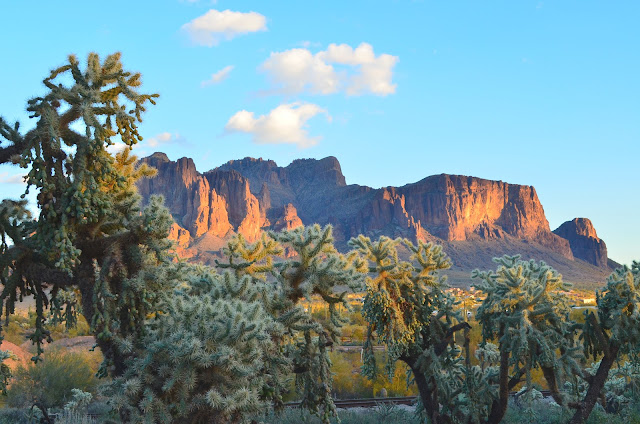Landscape Photography
Just a grey chunk of rock, or an intriguing mountain with mysterious stories of history and hauntings?
This is Superstition Mountain with a host of interesting history and hist-stories of its own.
Its shape is curious, but from a photography perspective, unless you wait for just the right time of day to shoot it, position, and contort your body for the perfect angle-as I did here, it shoots as just another huge grey chunk of rock sitting alone in Arizona.
For me, the west presented a whole different mindset for great photos because- as most of my friends know, I'm more of a purist. We did a wonderful exercise at cnn using software to enhance our photos, but since they're "news" they would only post things raw; completely unaltered in any way. For that reason, I guess I prefer to show reality in our natural world vs a computer generated work that's not really relevant to anything is my view.
That said, the challenge of using what nature offers us with light, weather and water steps up the whole process a bit for nature photographers and one of the reasons I love it. I feel it means more to make the best out of what is real than merely enhancing it with software. That's just my personal opinion.
The biggest challenge was the west for me. For one, the long drought destroyed a lot of green and left a lot of the available vegetation we use so often to enhance our photos brown. The lush green we're so used to on our mountains in the East wasn't there in a lot of places. Their seasons are also at different times from those in the east, so if you don't like surprises research before you leave and plan accordingly.
Their geological history is very different from the east so where there are no trees on the mountains, they do have intriguing shapes, unlike most of the east, and that can be showcased, especially if you let Mother Nature assist. Be cognizant of capturing them with the right lighting and your positions to portray their unique bends and beauty. They vary in their composition regarding what type of rock and if they were volcanic or not so that's another possibility to showcase the beauty only the west can offer.
Trees are frequently cacti so set your camera to also reveal their unique traits, with natural lighting being your best friend. You'll also discover areas where lava flowed millions or thousands of years ago, so instead of grass like in the east, focus-literally, on capturing that in it's best light. Again, literally. Instead of color, you'll need to be attentive instead to texture and curious shapes for a photo above the rest.
If you spent most of your life photographing in the east, the west is an especially good place to stretch your creative brain and offers new challenges and opportunities to develop that special photographers eye and brain that may take years otherwise.
Happy travels

.jpg)


Comments